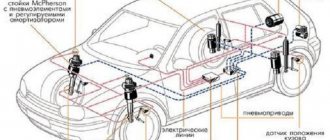Steve Mattin early career
It's 1997 and Autocar magazine names 33-year-old Steve Mattin Designer of the Year for creating the look of the Mercedes-Benz A-Class. The miniature A-class was just the beginning, followed by the design of the majestic Maybach, S-class, ML-class of 2005, the SL-Class were also the work of Mattin.
But all these, undoubtedly excellent, works simply pale in comparison to the design of the Mercedes-Benz SLR McLaren . It was the silhouette of this car that was familiar to every boy in the 2000s.
Mercedes-Benz SLR McLaren
Lada Vesta - what kind of platform are you made of?
Lada Vesta, or rather its platform, was built initially on the basis of the Lada B, which in turn was a continuation of the Lada C platform (2006) - a joint project of AvtoVAZ and the Canadian one. This interesting platform had, in particular, a very beautiful design, high crash test scores (13 points out of 16 according to EuroNCAP), and a high drag coefficient (0.32). However, it did not go into production, and with the acquisition of part of the AvtoVAZ shares by the Renault-Nissan concern, as well as the arrival of Bo Andersson to the leadership, the platform began to be increasingly unified with Renault-Nissan products. If we clarify what platform the car is currently built on, we will see our own platform, based on the Lada B, but with a design developed by Steve Mattin for the LADA XRAY. Indeed, we see a lot of similarities in the design of both cars. Many elements of the Lada also have much in common with the cars of the Renault-Nissan concern. Which undoubtedly helps to unify the parts.
Bo Andersson, when he wondered what AvtoVAZ should build a new model on, quite logically decided that the Lada Vesta was a new car and platform that should be its own, and one that had been developed for a long time. The Lada B platform suited these parameters. It had a history of development since 2006. Which means it was well worked out. The Vesta project had a modern design and was supposed to make a splash, which it did, thanks to the design of Steve Mattin. Many successful developments of the Renault-Nissan concern have also found application where similar Russian ones did not meet the requirements of quality, reliability or manufacturability
People often ask, “Whose car has a larger component in the development of the platform - Russian or French-Japanese?” It is recognized by all that the serial Vesta has an original platform based on Russian developments.
The Vesta project provided for the further development of the platform. The Vesta concept also provided for the unification of parts with other models of the Renault concern - Nissan, and AvtoVAZ. Which was successfully achieved.
There are several Vesta bodies. In 2022, the sedan body was replenished with a station wagon. In the future there will be other body models. All bodies are galvanized on the outside, which is in contact with an aggressive environment. The body is galvanized with 6-year corrosion resistance (no Lada has ever been produced with such a guarantee before). The torsional rigidity of the body is also high. In terms of safety, Vesta received 4 points out of 5, thus ahead of even some foreign competitors. However, it must be taken into account that these tests were domestic in Russia and were carried out with cars produced in Russia, such as the Ford Focus and Renault. The final result should be expected from tests conducted by foreigners.
The Vesta sedan is distinguished by its elegant appearance and comfort. The station wagon made it possible to use the interior space of the car even more.
Many elements of the Lada Vesta are completely original. For example, the original L-shaped front suspension with steering knuckles. Some elements are borrowed from the Renault Megane - the steering, for example. What was new was a body with a subframe on which the engine is mounted; this had never been used on Ladas before. The rear suspension of the Vesta was copied from the Renault Megane.
The Lada Vesta has a wider track than others in its class - 1510 mm, which means it is more stable on the road, there is more space for the driver, especially for passengers in the rear seat, the wheel arches are more spread out, and the useful volume of the trunk is also increased. The increased wheelbase is 2635 mm, which is even longer than in the “C” class!, and Vesta competes with the class below!
The ground clearance is not small - 171 mm (at full load), which is very important for Russia and its roads.
Thanks to the large size of the car, the suspension was able to be made with a longer stroke - the front compression and rebound strokes are 82 and 88 mm, respectively, and the rear - 100 mm each.
So, we see that the basis of the body was the “LADA C”, but with numerous modifications, the rear suspension is very similar to the Renault Megane, the front suspension was developed from scratch, the steering is also almost identical to the Renault Megane.
The most important feature of the Lada Vesta is the noise and vibration reduction system; it was taken into account during the development of the body. As well as shock absorption elements in case of a frontal impact.
The design of the car provided anti-gravel protection along the entire lower surface of the body. Both the bottom and sills of the car have it. And the doors are designed in such a way as to prevent snow from getting inside the cabin when opening the door in winter.
A range of engines from 1.6 liters (106 hp) to 1.8 liters. (122 l.) with manual and automatic transmissions, as well as a robot.
An interesting variety is the Vesta with pre-installed gas equipment, which allows you to drive on both economical gas and gasoline.
In the near future, the manufacturer also promises a diesel engine developed by Renault-Nissan.
Serial Vesta pleases owners not only with its appearance, quality of parts, but also with price. They start from 594,900, and up to 824,400 rubles, in the maximum configuration. Of course, dealer prices vary.
The president of the auto concern also announced that after some time the LADA Vesta SW Cross would be released, and it came out. This model has the features of a crossover. Vesta SW Cross will have larger wheel sizes and ground clearance will be increased to 203 mm.
Steve Mattin at Volvo, followed by Russia and AvtoVAZ
After a successful career at Mercedes-Benz, at the age of 40, Steve moved to Volvo as the brand's chief designer. Under his leadership, the following designs were created: XC60, V40, S60. These were some of the most successful years for the Swedish brand.
But how did one of the best designers end up at AvtoVAZ? To be honest, AvtoVAZ cars have never been able to boast of design: they are clumsy, uncomfortable - they were taken only because of their simplicity and cheapness.
The owners of those cars, even in their best dreams, could not imagine that literally in a few years domestic Ladas would seriously compete with foreign cars, albeit not in the premium segments.
Renault-Nissan and Steve Mattin save Lada from losses
And everything changed with the arrival of Renault-Nissan, for the first time LADA stopped feeding customers with promises to release updated models. The first project was created in the shortest possible time - it was Lada Granta.
There was more than one project in the plans, Granta was just the beginning, and a stellar chief designer was required to implement all the ideas.
On the list of vacancies being considered, work at AvtoVAZ was in last place, but realizing that LADA was the strongest challenge and he would have to create not just a model, but the face of an entire brand from scratch, Steve agreed. Having taken the place of the chief designer, the most painstaking work began - to understand what the Russian person wants, what excites him, what he likes.
After much research, the choice fell on the X-shaped design:
Vesta , X-ray , Granta - they were all created in the same style. Steve Mattin managed to do what could not be created for years - a single concept, a coherent image, the face of the brand.
Having received a company that produced archaic cars (VAZ-2107, Priora were on the assembly line), he did a titanic job: created a professional team and laid the foundation for further development. And Lada was transformed, became the most popular brand in Russia - people really loved it, and Steve Mattin brought a huge contribution to this.
An excursion into the history of the creation of Lada Vesta
August 2014 became a significant milestone in the history of LADA Vesta.
It was at this time that the Moscow International Motor Show satisfied public interest and presented a concept car created in the Vercarmodel studio in Turin. At the request of AVTOVAZ, five more samples were made: one LADA Vesta WTCC concept, as well as two XRAY and LADA Vesta concepts each. Two concepts were needed due to the demonstration taking place at the same time in Togliatti. According to AVTOVAZ chief designer Steve Mattin, due to a lack of funds, production models will differ slightly from the presented samples. In the exhibition concept cars offered to the public, the most simplified filling is used, and with the help of various tricks the appearance is embellished.
Who owns the car interior?
The interior design of the LADA Vesta belongs to the talented Tolyatti designer Andrey Bessolitsin, who previously fruitfully worked on the updated Priora and Kalina-2. The control unit for the Vesta climate control system remains the same, from the VAZ.
Innovations include a multifunction steering wheel, instruments in so-called wells, seat upholstery in original material with colored decorative inserts.
The interiors of production cars will be almost identical, differing favorably from the interiors of models of previous years, and a person, once behind the wheel of a LADA Vesta, will, as they say, feel the difference.
The car that is planned to be launched into series and the LADA Vesta concept have similar dimensions. However, not a single production part can be found in the concept. Vesta is intended to become a replacement for Priora, the brainchild of the Lada B project, and will be in the middle of classes B and C.
The Lada Priora and the concept have the same length of 4.35 m, but the LADA Vesta has a wheelbase of 2.65 m, which is 15 cm longer than the Priora.
Julien Droir, who worked for eleven years at the Renault design center and won the competition for Vesta’s exterior, is responsible for the appearance of LADA Vesta. Later, as a more knowledgeable and experienced specialist, he was entrusted with the exterior of the LADA XRAY. Mattin and Drouard did not become participants in the project from the first days of its existence. Before this, the Togliatti team already had good developments of their own and alternative options in favor of the Niva and Renault.
About borrowing
Much of Project C formed the basis of the Vesta platform, but there were also many undeniably successful borrowings, which, by the way, included the rear suspension beam from Renault. Although the LADA Vesta was designed here in Russia, to create the concept it was decided to turn to the well-established Vercarmodel studio, whose designers have distinguished themselves over the past two years with such concepts as the Honda Civic Tourer Concept, Porsche Sport Turismo Concept, SsangYong SIV-I, Kia Provo , Changan CS95, Subaru Viziv Concept, Hyundai i-oniq.
Conclusion
Each concept car is based on completely original technology, based on the use of fake interior parts and body elements. To be specific, the concept is simply a foam plastic dummy mounted on a metal frame with wheels and a power plant in the form of an electric motor, a manual transmission and lead-acid batteries located in the free cavity of the engine box and under the luggage compartment.
Foam body parts are manufactured on five-axis machines according to three-dimensional drawings created using special computer programs.
The basis for creating the seats are seats from other cars, re-covered with foam rubber and covered with leather in order to give the desired shape and appearance.
The front panel consists of a plywood base and a modeling tape applied to it. They give, so to speak, a marketable appearance using a film similar in texture to the imitation material, leather or plastic. And only, perhaps, the glass and wheels can be called real. True, the wheels will also be upgraded. All excess is cut off from them, and then a new appearance is made from the model polymer.
When everything is ready, assembly, adjustment and finishing takes place. The result is so realistic that even an advanced motorist will have a hard time guessing that in front of him is just a mock-up that cannot make you enjoy either the noise of the engine or the intoxicating speed. Yes, this is not required. The purpose of concept cars is to arouse the interest of potential buyers, and we must assume that the LADA Vesta concept does this well.
Change of designers
Time flies and in January 2022, after spending 9 years as chief designer, Steve Mattin leaves, but will remain as an advisor. His post will be taken by a Frenchman from Dacia, Jean-Philippe Salard. His track record includes such models as: Duster, Sandero, Logan, Arkana - we hope that we will not see any drastic changes in appearance towards Logan.
I would like to wish AvtoVAZ not to lose everything that has been done and created over the past 9 years and to preserve its X-shaped style, and the legacy that Steve Mattin left behind.
How AvtoVAZ chief designer Steve Mattin lives in Russia
The chief designer of AvtoVAZ, Briton Steve Mattin, has been living and working in Russia for four years. Having exchanged Foggy Albion for a slow life in Togliatti and weekly flights to Moscow for the weekend, Mattin claims that the main thing for him is his calling, not his environment. Quite recently, production of the new Lada Vesta sedan began in Russia, the appearance of which a foreigner worked so hard on. Gazeta.Ru talked to Steve about contrasts, paid parking, skydiving and how autumn leaves on the asphalt can inspire the creation of a new color for cars.
— Steve, you have been working in Russia at AvtoVAZ for four years. This is even longer than the head of the company, Bo Andersson himself. How did you live all this time in Tolyatti and Moscow, where AvtoVAZ also has its own design studio?
close
100%
— Russia is a huge country, and the longer I live here, the more experience I gain. Every day something new happens. I'm very lucky because I actually have two places where I live and work. And I can see the contrasts between Moscow and Tolyatti. This is important for me, because four days a week I work in Tolyatti, and on the fifth I can think about new projects and develop new strategies in the capital. In Moscow the pace of life is much higher than in Tolyatti, everything happens very quickly and changes very quickly. At the same time, the city is focused on cultural development.
There are many differences in Moscow: for example, the fashion is different, people here drive completely different cars, the architecture and interiors are different here. The restaurants, the culture, the people and their behavior are all very different.
The Moscow office allows me to get all this, understand Russian people and be inspired by the history of the city and the creative atmosphere.
— What are your favorite places in Moscow?
— I walk a lot, I like to walk around the center and explore the life of the city. I always have a camera with me, so you can say that with its help I paint the whole picture of my life in Russia. I absorb everything around me and try to find inspiration. I love going to various cultural events.
For example, I go to the opera or ballet, I have never done this before! But here it is one step away from me and very easy to do.
I love visiting exhibitions. All this gives me the opportunity to disconnect from hard everyday life and reboot my brain. After all, designers are like that - they always need to look for inspiration. For example, you might look at the color of autumn leaves and decide that this would be a new color for your car. Landscapes, views - also from the same song. So, the interior details in the Vesta sedan were inspired by cracks in the ice of reservoirs. And the same can be said about ballet or opera. The atmosphere, the expression of people - all this can be put into shapes and colors. So there is a strong connection between the way I live and work. It may not be that noticeable, but it is important.
— Has your perception of Russia changed much compared to your first impression?
— Yes, a lot has really changed during this time. This is especially noticeable in Moscow. When I first came here four years ago, the traffic in the city was absolutely terrible!
There was no regulation of parking space, everyone threw their cars in two rows! Complete chaos.
With all these parking restrictions that have appeared in the capital, the city has become much more pedestrian friendly. It has become easier to move around, and it has become easier to find a parking spot. The city has become completely different - there are now many more pedestrians and less traffic jams.
All over the world it is normal to pay for parking. Previously, you could not do this and leave the car anywhere. Of course, if I used the car in everyday life, like Muscovites, perhaps I would also be upset, like all these people. But…
— So you travel around Moscow mainly by metro?
- Yes, sure. It is convenient and much faster, especially if there are traffic jams in the city.
True, I didn’t take the metro during rush hours - I’m sure that at that time it’s certainly not so convenient.
But if it’s a long walk to my goal and I’m not in a car at that moment, then I can take public transport without any problems. In addition, the Moscow metro is truly the most beautiful I have ever seen. Each station has its own face, its own character, which comes from the past.
— When you first arrived in Tolyatti, did you have such thoughts: “What am I doing here, I want to go back!”?
- Oh no, I didn’t want to go back. Of course, this is a completely different environment. I've lived in cities that are so small, like Sweden. There was a town with a population of about 700 thousand people. Of course these places are different. That place was located on the sea coast. Tolyatti is also located next to the water, there is a lot of nature there. I live in the Fortuna complex, which belongs to AvtoVAZ, it is located close to the river.
On the one hand, this is very good; there is an opportunity to be closer to nature. That is, this is not an industrial city in the middle of nowhere.
But it's different from what I'm used to. There are no cultural objects there, the buildings are very old. Everything that was built there was created during the construction of the plant.
But in this business you don't choose the environment, you choose your work. And you accept that compromises must be made.
If you go abroad, you leave behind your family and friends. But in return you get an incredible life experience, and this opportunity doesn’t come around every day.
— Do they recognize you on the streets?
- No, to be honest, I don’t feel any increased attention. Sometimes people actually recognize me, but this happens mainly in Moscow. So I'm glad I can lead a normal life.
— What other interesting things can you see or experience in Russia?
close
100%
— I go to everything that interests me and that fits into my work schedule. For example, I have loved motorsports since childhood.
Therefore, for the second time in a row I visited the Formula 1 races in Sochi. I myself participate in the Lada Racing races, which take place in Sosnovka in Tolyatti.
There was also an interesting event a couple of years ago. One of my friends in Togliatti got married, and we went on a two-day rafting trip down the Volga by boat. I don’t know, maybe this is the usual way for Russians to celebrate weddings, but for me it was very unusual and I really liked it!
— I saw photos of a parachute jump on your Facebook...
close
100%
- Oh yeah! It was a completely crazy experience. Most people have never done this in their life. In Russia, I had such an opportunity.
It was very strange to be on an old plane, tightly attached to a person I didn’t even know! And jump out of the plane with a parachute together with him.
After the jump, you have about a minute of free fall. You fly, look at the ground, which is 4 km away from you, and just enjoy the moment. This is very scary, but it is an important experience in life, a lot of adrenaline and nerves! You will never forget this! If you get the chance, I highly recommend it.
— What about the opportunity to meet with family and friends?
— This is perhaps the most difficult moment in my life in Russia. You can't meet someone spontaneously. Everything needs to be planned in advance, wait for long holidays or add additional vacation days to the weekend. And it’s not easy to just come to Russia. You need to get a visa and plan your trip. Of course, we have Facebook, we have Skype. But of course I miss my family and friends. Luckily, I have a lot of friends in the industry. We meet quite often at various events, such as car shows. And when I go to visit family in the UK, I try to meet as many friends as possible.
— Probably everyone also asks you about Russia?
- Yes, sure! Everyone has very different ideas about the country.
close
100%
Everyone is interested in knowing ordinary things: how people live, what you do on weekends, what the difference is with other Western countries or with Eastern countries.
But I have friends in Japan, the USA, Australia, Europe, and each culture has its own characteristics.
- Now the first car that you created at AvtoVAZ - Lada Vesta has finally gone into production
. Are you happy, proud?
“When you see that a project you’ve been working on for so long has been brought to life, you feel very proud.
That's why we remain in this profession until the end of our days. It is important for the designer to see how the sketch becomes reality and the car appears on the streets of the city.
close
100%
Now sales are starting, this is an emotional and exciting moment not only for me, but for the entire team. It was a real challenge. But this is exactly why we are here: to take on these challenges and change the brand as much as possible.
I believe in what I do and this work is no less important to me than what I did at Volvo or Mercedes-Benz.
— Will you have your own Vesta?
“I can’t wait to receive it.” Of course, all this will depend on the company's management. I will mainly drive it around Togliatti - in Moscow I practically don’t need a car. But for now I don’t even know what color it will be!
— Vesta was recently tested by President Vladimir Putin...
— Yes, it was a good PR campaign. And his support is important to us. He had already driven our cars before, but then it was a Kalina. Now it's a brand new car and I hope he likes it.











